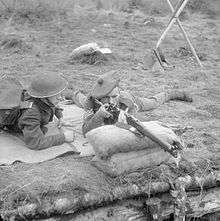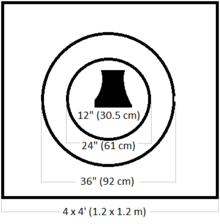Mad minute

_-_UK_-_cal_303_British_-_Arm%C3%A9museum.jpg)
The Mad Minute is best known as a bolt-rifle speed shooting event, which was derived from a pre-World War I rapid-fire exercise used by British Army riflemen, using the Lee–Enfield service rifle. The exercise (Practice number 22, Rapid Fire, ‘The Musketry Regulations, Part I, 1909) required the rifleman to fire 15 rounds at a “Second Class Figure” target at 300 yards. The practice was described as; “Lying. Rifle to be loaded and 4 rounds in the magazine before the target appears. Loading to be from the pouch or bandolier by 5 rounds afterwards. One minute allowed”. The practice was only one of the exercises from the annual classification shoot which was used to grade a soldier as a marksman, first-class or second-class shot, depending on the scores he had achieved.
The “Second Class Figure Target” was 48" square (approximately 1.2 x 1.2 meters), with 24” inner (61 cm) and 36” magpie (92 cm) circles. The aiming mark was a 12” x 12” (30 x 30 cm) silhouette figure that represented the outline of the head of a man aiming a rifle from a trench. Points were scored by a hit anywhere on the target. Although a 12” target is often mentioned in connection with the Mad Minute practice, this seems to have been an error originating in Ian Hogg’s book, ‘The Encyclopedia of Weaponry’. No other source mentions a 12" target. Thus according to the myth the target size would have been a 1.11 mil circle (3.82 MOA), while in reality the target size was a 4.5 mil square (15.3 MOA) making the area counting scoring hits over 15 times bigger.
World record

The first Mad Minute record was set by Sergeant Major Jesse Wallingford in 1908, scoring 36 hits on a 48 inch target at 300 yards (4.5 mils/ 15.3 MOA).[1] Allegedly another world record of 38 hits, all within the 24 inch target at 300 yards (2.25 mils/ 7.6 MOA), is said to have been set in 1914 by Sergeant Instructor Alfred Snoxall,[2] but there is little documentation and it is unsure whether it was actually accomplished or British propaganda. There has been major discussion whether it is actually possible to shoot that fast and accurate with a bolt rifle.

A Mad Minute event was held in Soknedal, Norway, on 30 May 2015 featuring some of the best stang shooters in the country.[3] The competition was called the "Mad Minute Challenge", and was shot at a round 40 cm diameter target at 200 meters (2 mils/ 6.9 moa), making the target smaller than original. The winner, Thomas Høgåsseter, scored 36 hits. The average score, of 11 shooters, was 29.
Target section sizes
The tables below are based on the sections (12, 24, 36 and 48 inches) of the original Second Class Figure target placed at 300 yards, and shows the same relative target sizes for different ranges. The military calibers from that time (such as .303 British, 6.5×55mm, 8x57mm etc.) are more high powered and with less wind drift compared to modern military calibers (such as 5.56 NATO, 7.62x39mm, etc.). With the high powered calibers wind drift will barely be noticeable at 100 m, slightly more at 200 m and will only become a small factor at 300 m.
- Equivalent imperial target sizes
| Relative size | 100 yd (91 m) | 200 yd (183 m) | 300 yd (270 m) |
|---|---|---|---|
| 3.82 MOA (1.11 mil) | 4 in (10 cm) | 8 in (20.3 cm) | 12 in (30.5 cm) |
| 6.75 MOA (2 mil) | 7 in (18 cm) | 14 in (35.5 cm) | 21 in (53 cm) |
| 7.64 MOA (2.22 mil) | 8 in (20.3 cm) | 16 in (40.6 cm) | 24 in (61 cm) |
| 11.46 MOA (3.34 mil) | 12 in (30.5 cm) | 24 in (61 cm) | 36 in (91.4 cm) |
| 15.3 MOA (4.5 mil) | 16 in (41 cm) | 32 in (81 cm) | 48 in (122 cm) |
- Equivalent metric target sizes
| Relative size | 100 m | 200 m | 300 m | Explanation |
|---|---|---|---|---|
| 1.11 mil (3.82 MOA) | 11.1 cm | 22.2 cm | 33.3 cm | Size of aiming mark of the Second Class Figure |
| 2 mil (6.75 MOA) | 20 cm | 40 cm | 60 cm | Target size used in the modern Mad Minute Challenge, scoring only 1 point per hit (2015 record of 36 hits) |
| 2.22 mil (7.64 MOA) | 22.2 cm | 44.4 cm | 66.6 cm | Inner ring of the Second Class Figure (3 points), sizes equivalent to the myth of Alfred Snoxall 38 hits |
| 3.34 mil (11.46 MOA) | 33.4 cm | 66.8 cm | 100 cm | Outer ring of the Second Class Figure (2 points) |
| 4.5 mil (15.3 MOA) | 45 cm | 90 cm | 135 cm | Outer square of the Second Class Figure (1 point) |
Other uses
Early use
The term was originally used as a description of the time it took to reload a musket during combat in the 18th and 19th century. Enemy formations would be lined up standing shoulder to shoulder, facing each other in ranges from fifty to several hundred meters with relatively inaccurate and slow-loading muskets. After firing a shot each soldier would race to reload his musket as fast as possible, while the enemy was doing the same. Due to the muskets' limited accuracy the description was especially relevant at close ranges.
Vietnam War
In the Vietnam War, the "mad minute" was used to describe a drill involving intense automatic weapons fire, intended to flush out infiltrators or ambushes. The area targeted would be something which provided potential concealment for an enemy but not very good protection from projectiles, such as the vegetation line at the edge of a field, or at the edge of a cleared free fire zone around a fire base. All soldiers involved would direct the heaviest rate of continuous fire they could into that area for one minute.
Military use today
"Mad minute" has remained as an expression in military terminology to describe any short period of intense weapons fire.
A more "peaceful" variation of the mad minute, one which lasts for some specific designated amount of time more than a minute but is often referred to as a mad minute, continued on into peacetime. It consists of security personnel stopping and checking every single vehicle (and its passengers) in a certain area. Such mad minutes are usually limited to installations, or parts of installarions, which are considered to be high threat terrorist targets, and most often occur during periods when threat conditions are considered higher than normal. This version of the mad minute was also used in Vietnam, when specific areas of highway or urban areas would be subjected to mad minutes.[4]
See also
References
- ↑ Historical Firearms - The Mad Minute
- ↑ Ian V. Hogg, The Encyclopedia of Weaponry, Sterling Publishing, New York 2006.
- ↑ Soknedal Skytterlag - Norgescup stang og felthurtig 2015
- ↑ http://www.dtic.mil/cgi-bin/GetTRDoc?AD=ADA194507&Location=U2&doc=GetTRDoc.pdf
External links
- Historical Firearms - The Mad Minute
- Video: Thomas Høgåsseter sets the world record of 36 hits in Soknedal, Norway 30 May 2015